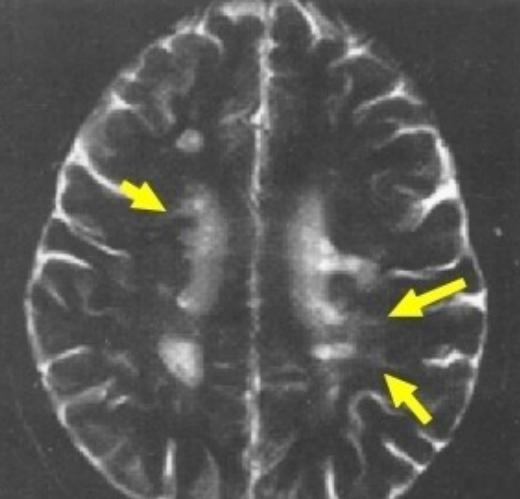Solar Bands:
Images show linear or curved abnormal signals radiating from the periphery of the lateral ventricles to the subcortex region of the cerebral hemisphere.
Solar bands may be seen in patients with knotty sclerosis and represent the abnormal migration of dysplasian stem cells along radial glial units, also known as migration bundles or linear abnormalities. The autoplasmic signals of radial abnormalities represent a variety of neural differentiations, astrocyte differentiation, and clusters of giant cells that are not easily classified. The same giant cells can be classified using different histological techniques. This suggests that tuberous sclerosis may be due to developmental disorders. It occurs early in development and leads to cell migration or incomplete astrocyte or neuronal differentiation.
Tuberous sclerosis (TSC) is a neurocutaneous syndrome in which abnormal cell differentiation and proliferation are accompanied by neuronal migration disorders. Lesions involve not only organs of ectoderm origin such as the nervous system, skin, and eyes, but also organs of the mesoderm such as the heart, lungs, bones, kidneys, and gastrointestinal tract. Clinical features are multisystem and multi-organ involvement. The incidence of this disease is about 1/100,000 to 3/100,000, the prevalence is 5/100,000, and the ratio of men to women is about 2:1, mostly in children and adolescents. The disease is autosomal dominant, and it has been reported that 44%
Or a higher proportion of children have a family history.

On both CT and MRI images, abnormal white matter hyperinflora (yellow arrow) were shown as radial mitigraphy from the side ventricles to the subsplenular cortex.
Central:
Intracranial nodular sclerosis can present with four typical types of pathological changes: cortical nodules, leukoplasm abnormalities, subependymal nodules, and subependymal giant cell astrocytoma.
The incidence of cortical nodules and subependymal nodules is 95%, the incidence of leukoplasmic abnormalities is 40% to 90%, although subependymal astrocytomytoma itself is relatively rare, but it is the most common brain tumor in patients with tuberous sclerosis, with a incidence rate of 26%, and adolescents are the peak of the incidence.
Subependymal calcified small nodules (<1.3 cm); subependymal giant cell astrocytoma (> 1.3 cm), the vast majority of which are located in the interventricular foramen
White matter radial migration line: represents ectopic glial and neuronal migration pathways from ventricles to the cortex
Cystic white matter lesions (cystic cerebral degeneration)
Cortical or subcortical nodules: early T1WI hyperinsity
Left: giant cell astrocytoma, subependymal small nodules, radial migration lines, subcortical nodules;
Right: Subependymal giant cell astrocytoma, located at the left compartmental foramen level, significantly uniformly strengthened.
Children with TSC at 13 months, multiple cortex or subcortical nodules, white matter radial migration.
【Copyright Notice】This platform is a public welfare learning platform, reprinted for the purpose of transmitting more learning information, and has indicated the author and source, such as teachers who do not want to be disseminated can contact us to delete